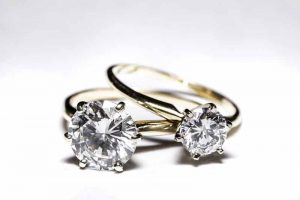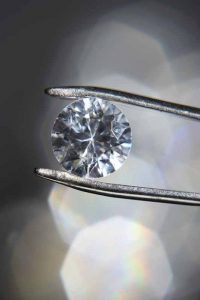Are synthetics poised to take over?
by carly_midgley | August 2, 2018 10:36 am
By Giselle Saati
 [1]
[1]The growth in popularity of gem-quality synthetic diamonds has the top players in the jewellery industry asking whether consumers will lose confidence in the long-term value of this gem. I have spent my entire career in the jewellery industry, and during my master’s studies, I investigated the likelihood of consumers accepting gem-quality synthetic diamonds, as well as how this might eventually drive down prices of their natural counterparts. I discovered many compelling arguments supporting the dominance of synthetic diamonds.
Supply and demand
 [2]
[2]In 2016, consulting firm Bain & Company published research on the supply and demand for rough diamonds. Demand is projected to grow at an average annual rate of two to five per cent from 2030, and supply is projected to decline by one to two per cent due to the aging and depletion of existing mines. (Learn more by reading Bain & Company’s The Global Diamond Industry: The Enduring Allure of Timeless Gems.) This rise in demand is partly the result of income growth in emerging Asian and Middle Eastern markets due to the adoption of western marriage rituals. (For more, see “Synthetic Gem-quality Diamonds and Their Potential Impact on the Botswana Economy” by R. Grynberg, M. Sengwaketse, and M. Motswapong in The Global Diamond Industry Economics and Development Volume II.)
Although an increase in demand will result in an increase in diamond prices, it will also result in a higher rate of penetration of synthetics into the market, causing a decrease in prices. Given the laws of economics, this would normally suggest a price equilibrium—but other factors are also at play. The increase in supply of high-pressure, high-temperature (HPHT) and chemical vapour deposition (CVD) synthetic diamonds will play a significant role in meeting the growing demand for the gem.
This accession to synthetics could also accelerate the decline of diamond mining. There have been no new large diamond mines discovered in over 15 years, and the gestation period on mining projects is long and costly. Given these factors, combined with the decreasing cost of synthetic diamond production, diamond exploration and mining may become less profitable.
Will history repeat itself?
 [3]
[3]The authors of The Global Diamond Industry draw a comparison between consumers’ acceptance of cultured pearls and rejection of synthetic rubies. Synthetic rubies were unsuccessful in disrupting the ruby market because they are generally of inferior quality and are easier and less costly to detect than other synthetics. However, this does not apply to the pearl and amethyst markets—cultured pearls are rounder and of higher quality than their natural counterparts. Also, the progressive decline of coral reefs has contributed to a decrease in the supply of natural pearls.
Amethyst provides another example of how the creation of synthetics has caused prices to decrease. When an electrical current is applied to an amethyst, the atoms vibrate at a consistent frequency, making the gem well-suited to keeping track of time and an ideal component in watches. After the Second World War, there was a high demand for and very low supply of natural quartz (i.e. amethyst), leading to the development of synthetic quartz in 1955. (More information is available here[4].) The prices of amethysts fell, as synthetic amethyst was of better quality and was easier and cheaper to produce.
Similarly, synthetic diamonds’ quality can be higher than that of their natural counterparts in terms of the four Cs. It has also become impossible for gemmologists to identify a synthetic diamond with a microscope or the naked eye. When considering the evolution of synthetics across other gemstone markets, diamonds follow the same pattern as cultured pearls and synthetic amethysts: there has been increased demand and low supply, the gemstones are of higher quality, and there is difficulty and cost associated with distinguishing synthetics from natural gems.
Selling to a modern market
Today, there isn’t a single market that has not been disrupted by technology. In evaluating the future growth potential of any industry, it is worth examining how the current players, big and small, are behaving. One of the biggest trends is the growth of online sales, which currently accounts for four to five per cent of sales and is expected to capture 15 per cent of the market by 2020. (For more information, click here[5].) Many online and established jewellery retailers, such as Spence and Stuller, are already selling synthetic diamonds as environmentally friendly and sustainably sourced.
Although global jewellery sales are expected to increase over the years, it is unclear if this is reflected in the North American market, looking specifically at the behaviour of millennials. Individuals in this age bracket are struggling with paying off student loans, opting for service-sharing platforms (e.g. car sharing), putting off weddings, and living with their parents in order to save to purchase houses. Further, millennials place a higher value on experiences as opposed to owning things. (More about millennial spending can be found here[6].)
Bain’s Worldwide Luxury Report states, “In addition to the shift toward purchasing luxury experiences, a few other luxury trends were particularly noticeable this year: increased casualization, the rise of discount and online, and a revitalization of local consumption.”
 [7]
[7]In other words, millennials are not spending as much money on luxury jewellery as previous generations. For instance, if a couple is buying an engagement ring, they are likely to spend less on the ring so they can put more money toward their honeymoon.
As a millennial, I can certainly empathize with this situation. Keeping in mind Moore’s Law—which states processing power of technology is increasing while its cost decreases—it is only a matter of time until the industry consistently develops perfect diamonds at a lower price. Consumers may ask themselves, “Would I rather spend less money on an IF, D colour synthetic diamond, or more money on a natural, VS1, F colour?”
Millennials have also shown a tendency to want to be different. Perhaps in the future, there will be a greater focus on customization of jewellery designs as opposed to varying diamond qualities.
Capitalizing on the change
 [8]
[8]Many different strategies can be employed to maintain a foothold in the world of synthetic diamonds. To illustrate one option, this article uses the example of De Beers.
Botswana is the world’s largest producer of mined diamonds by value. Diamond exports comprise 30 to 50 per cent of the government’s revenue in the form of taxes, royalties, and dividends paid by Debswana and De Beers. Therefore, the macroeconomic implications of a decline in gem-quality diamond prices would result in loss of revenues for Botswana and De Beers mines. (See Grynberg, Sengwaketse, and Motswapong’s article in The Global Diamond Industry Economics and Development Volume II.)
In the 1990s, De Beers responded to the threat of synthetics by launching a Gem Defence Program, which involved giving certain firms equipment to distinguish between synthetic and natural diamonds. Then, in 2000, the company repositioned and it introduced the ‘Supplier of Choice’ strategy, inscribing the Forevermark logo on selected natural stones. This was an attempt to capitalize on the retail side of top-end diamonds, which—after mining—is the most profitable part of the value chain.
De Beers is aware of the growth and potential profitability of synthetic diamonds, as it has been producing them through a subsidiary called Element Six. In 2010, this subsidiary issued patents to produce orange-coloured synthetic diamonds, which “may be used as gemstones.” Eight years later, De Beers launched its new gem-quality synthetic diamond line, Lightbox, which sells synthetics at a fraction of the price of natural diamonds. (Details on Lightbox can be found here[9].) In this line, a one-carat synthetic will sell for about US$800, compared to the $8000 its natural counterpart might fetch. Lightbox aims to appeal to millennials in North America who are seeking affordable fashion jewellery.
If one of the foremost players in the diamond industry is marketing and selling gem-quality synthetics, you certainly don’t need a crystal ball to predict the future of the trade. However, De Beers is far from the only player when it comes to synthetics. In the 1960s, De Beers and General Electric (GE) were a duopoly, but over the years Japanese and Chinese producers have begun dominating in the production of industrial synthetic diamonds. These producers have the resources and capabilities to compete in the synthetic gem-quality diamond space in the future. (For more, see Grynberg, Sengwaketse, and Motswapong’s aforementioned article.) There are also numerous other small synthetic diamond producers (such as the Diamond Foundry and Pure Grown Diamonds) advocating for the lab-grown trade.
Conclusion
It is very difficult to gauge consumers’ sentiments for and acceptance of synthetic diamonds. Bain conducted a survey in 2016 showing consumers in China, the United States, and India have mixed associations with these gems. Yet, based on the facts presented, it seems likely synthetics will eventually dominate the market. Keeping an eye on the strategies of larger brands will help provide an indication of where the diamond industry is heading.
 [10]Giselle Saati has been involved in the jewellery industry since childhood, as it is a family trade passed down for seven generations. She has worked full-time in the industry for a total of 11 years, and in areas including wholesale, retail, jewellery appraisals, and handmade jewellery. Before moving to Madrid to pursue her master’s studies, Saati worked at Harold Weinstein as a gemmologist and appraiser. She can be reached via e-mail at gisellesaati@gmail.com.
[10]Giselle Saati has been involved in the jewellery industry since childhood, as it is a family trade passed down for seven generations. She has worked full-time in the industry for a total of 11 years, and in areas including wholesale, retail, jewellery appraisals, and handmade jewellery. Before moving to Madrid to pursue her master’s studies, Saati worked at Harold Weinstein as a gemmologist and appraiser. She can be reached via e-mail at gisellesaati@gmail.com.
- [Image]: https://www.jewellerybusiness.com/wp-content/uploads/2018/08/bigstock-144776219.jpg
- [Image]: https://www.jewellerybusiness.com/wp-content/uploads/2018/08/bigstock-220755286.jpg
- [Image]: https://www.jewellerybusiness.com/wp-content/uploads/2018/08/bigstock-Diamond-held-by-tweezers-close-49176755.jpg
- here: http://www.gemma-quartz.com/en/history.php
- here: https://www.forbes.com/sites/deborahweinswig/%202016/04/14/as-fine-jewelry-moves-online-the-market-sparkles/#4484773e74ae
- here: https://www.forbes.com/sites/ashleystahl/2016/11/15/how-millennials-spend-their-money-hint-experiences-trump-possessions/#281b0b0b5cfb
- [Image]: https://www.jewellerybusiness.com/wp-content/uploads/2018/08/bigstock-Young-Woman-Buying-A-Diamond-R-155766653.jpg
- [Image]: https://www.jewellerybusiness.com/wp-content/uploads/2018/08/bigstock-Young-couple-choosing-ring-in-229968967.jpg
- here: https://www.thestar.com/business/2018/05/29/de-beers-to-sell-man-made-diamonds.html
- [Image]: https://www.jewellerybusiness.com/wp-content/uploads/2018/08/Screen-Shot-2018-07-07-at-15.43.09.jpg
Source URL: https://www.jewellerybusiness.com/features/are-synthetics-poised-to-take-over/